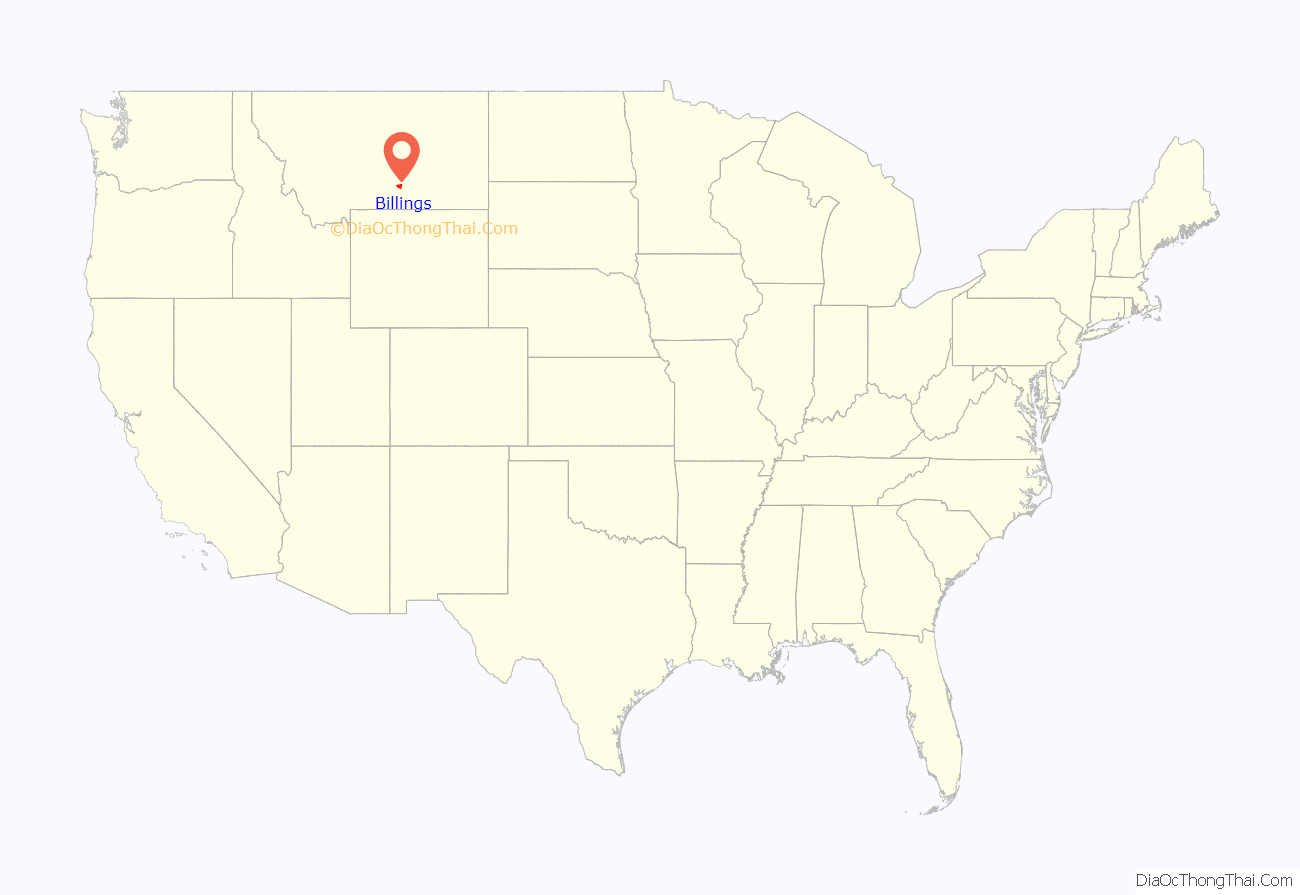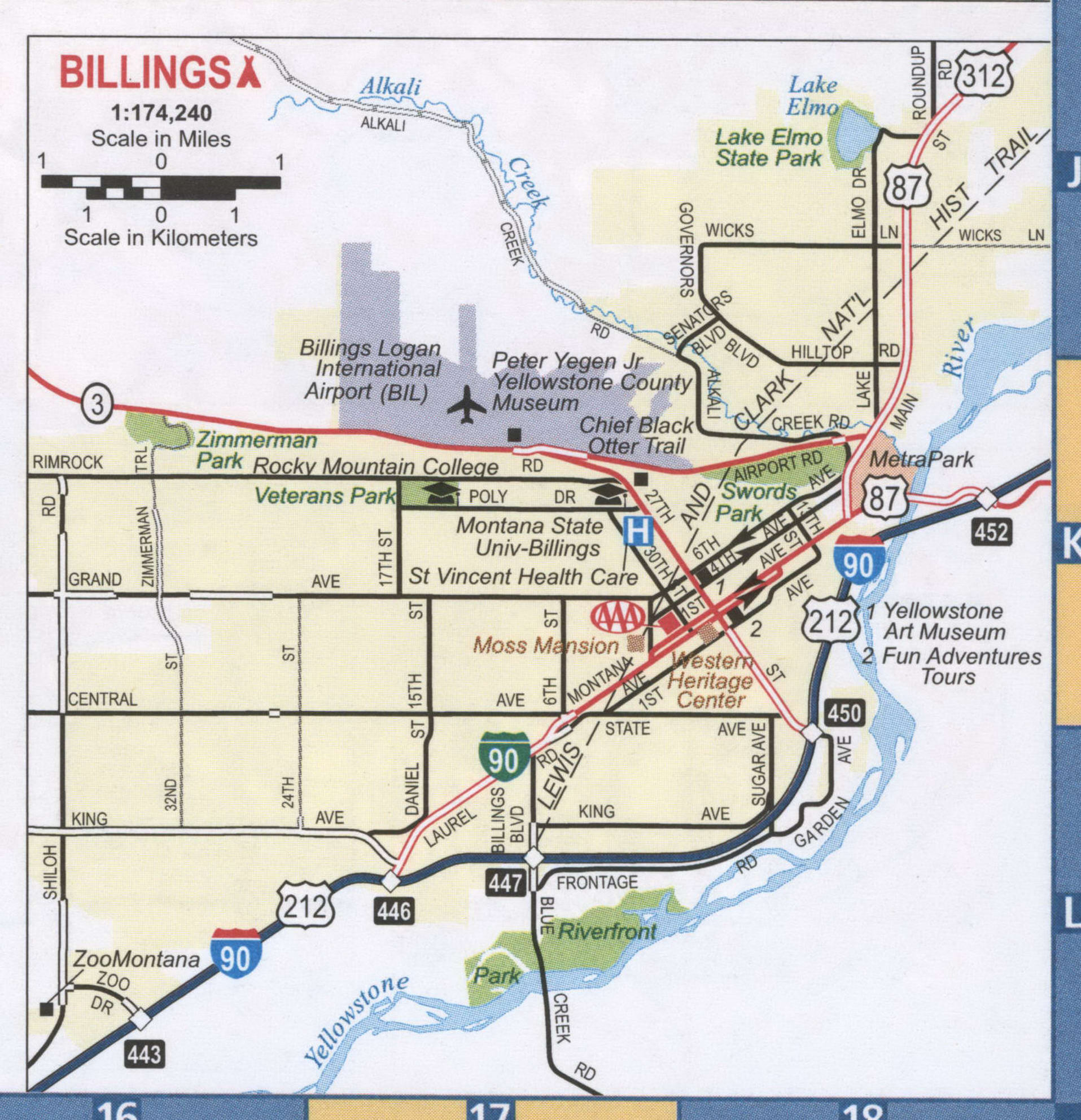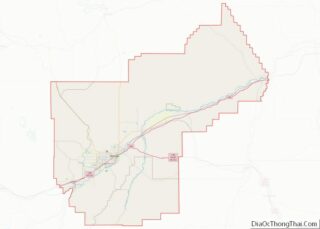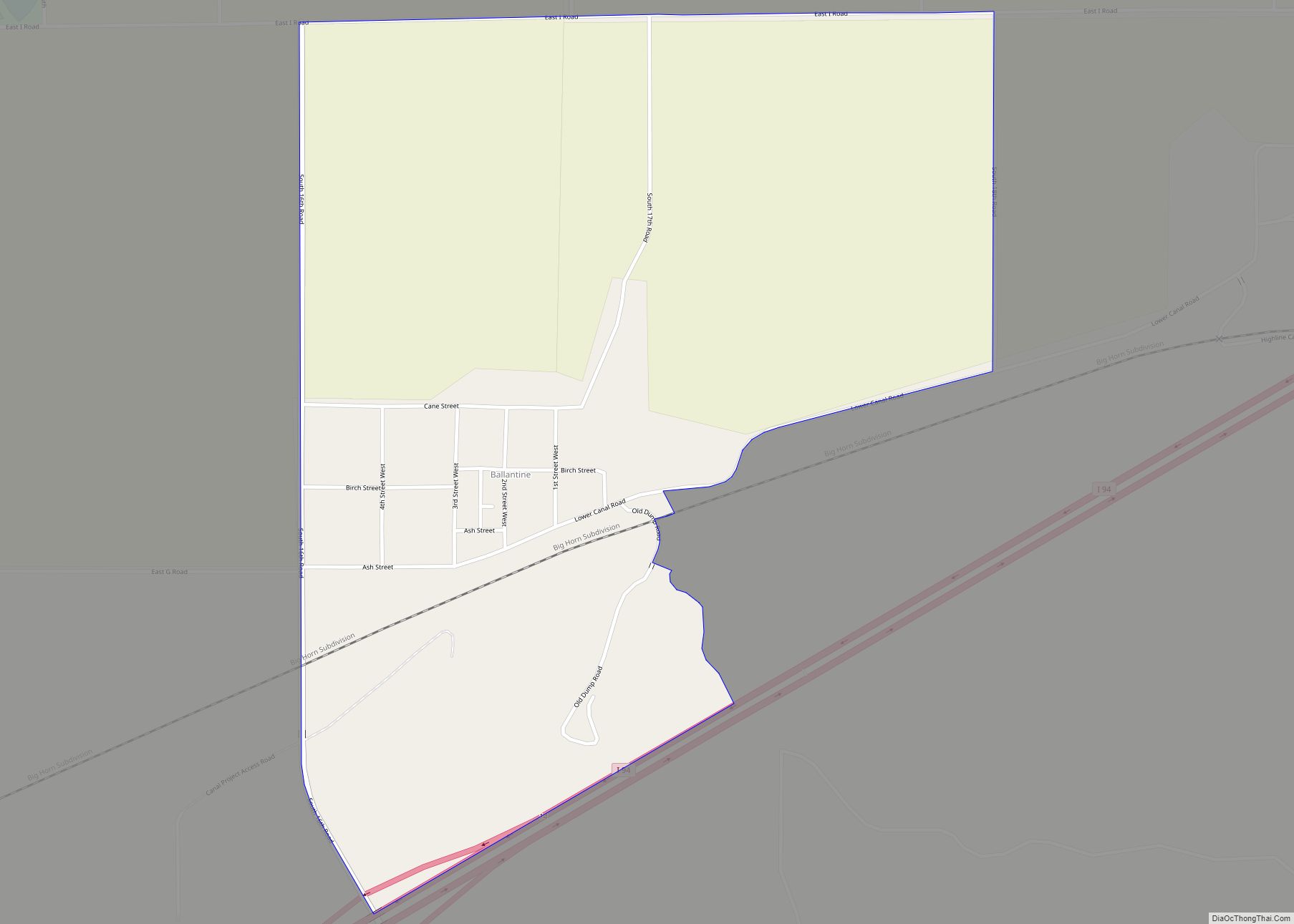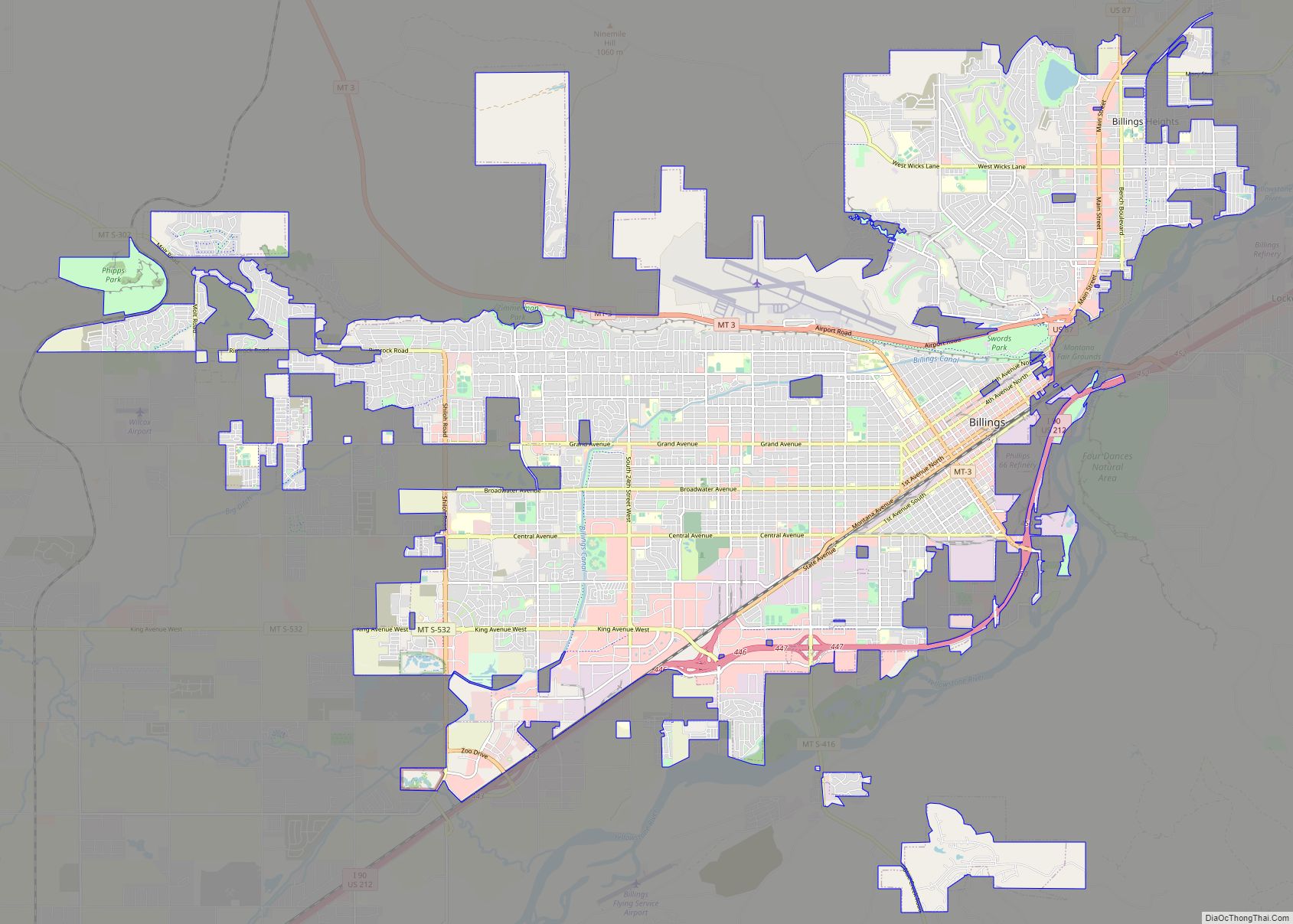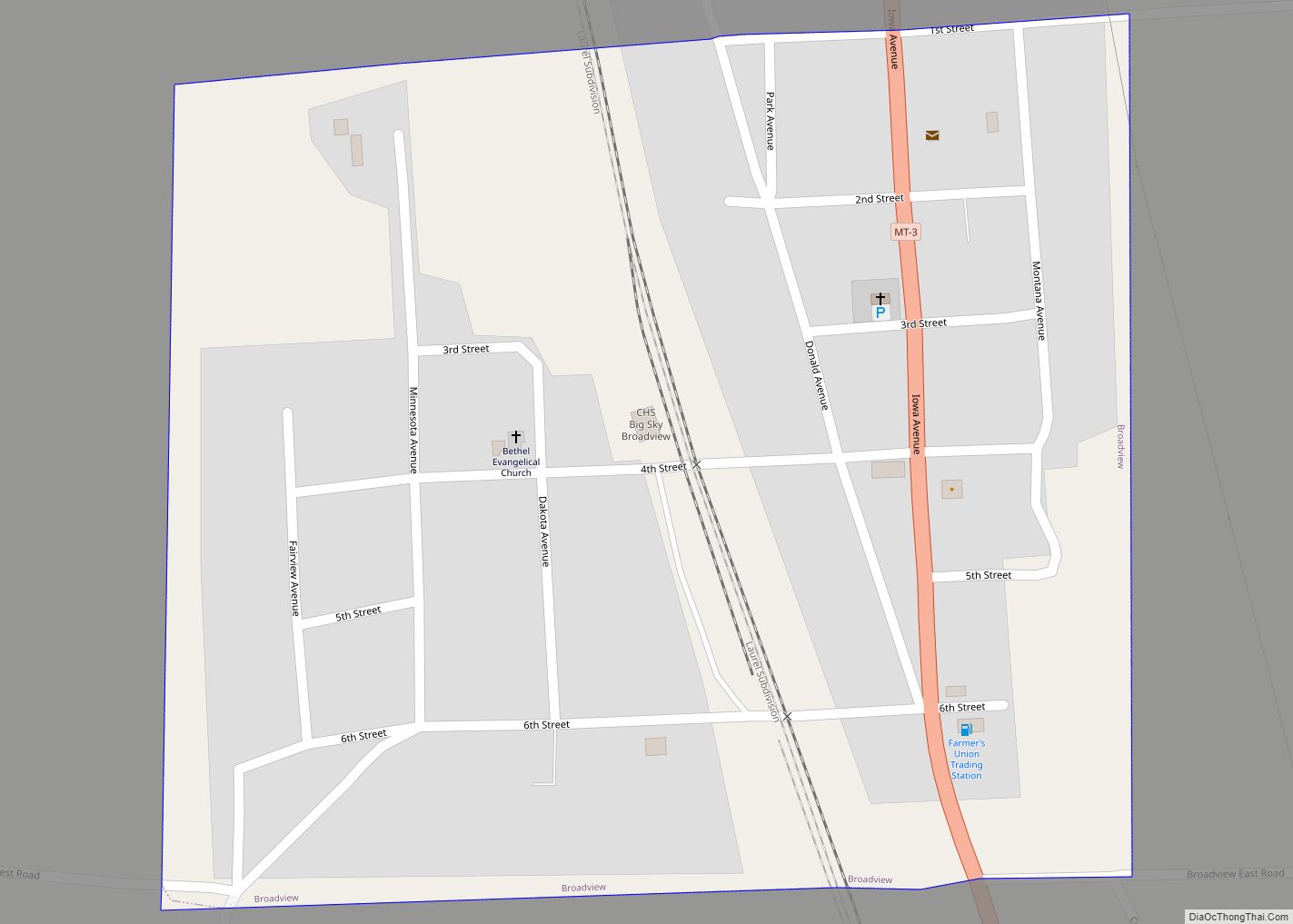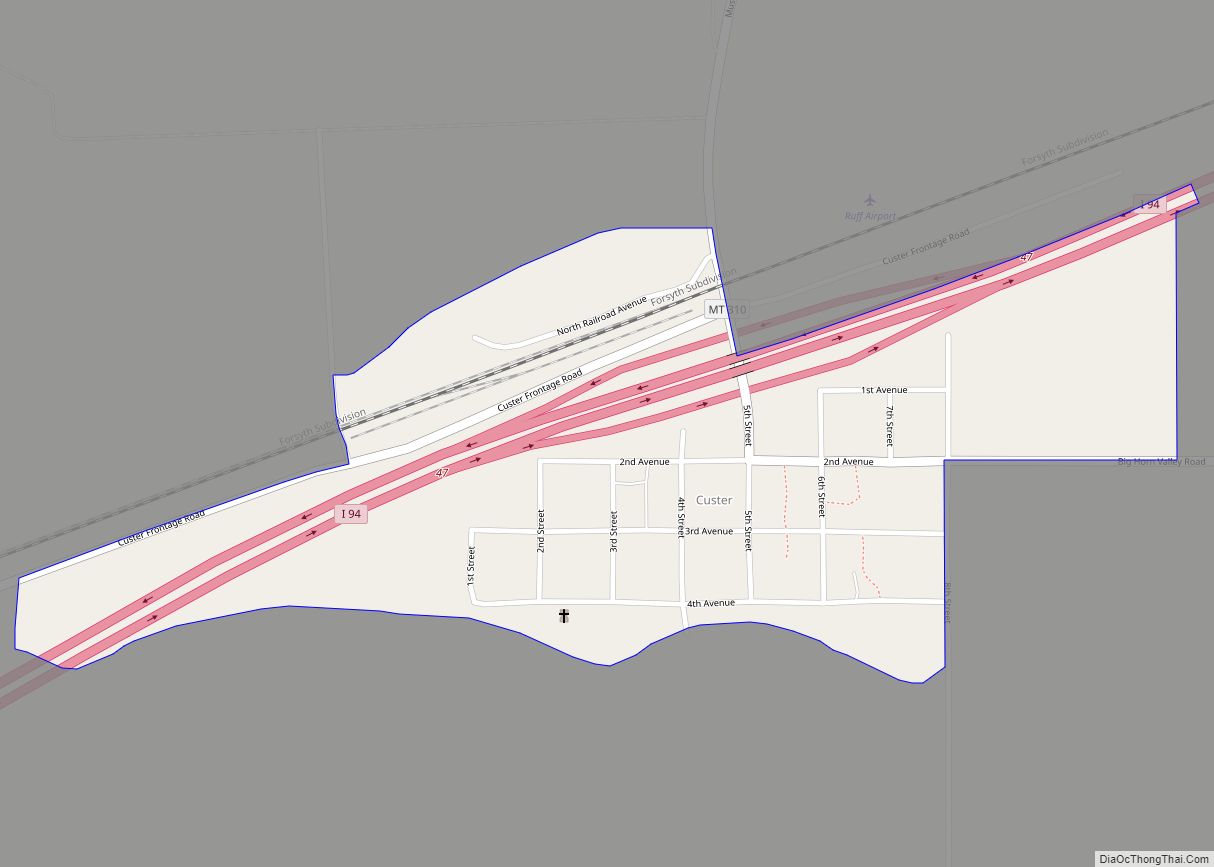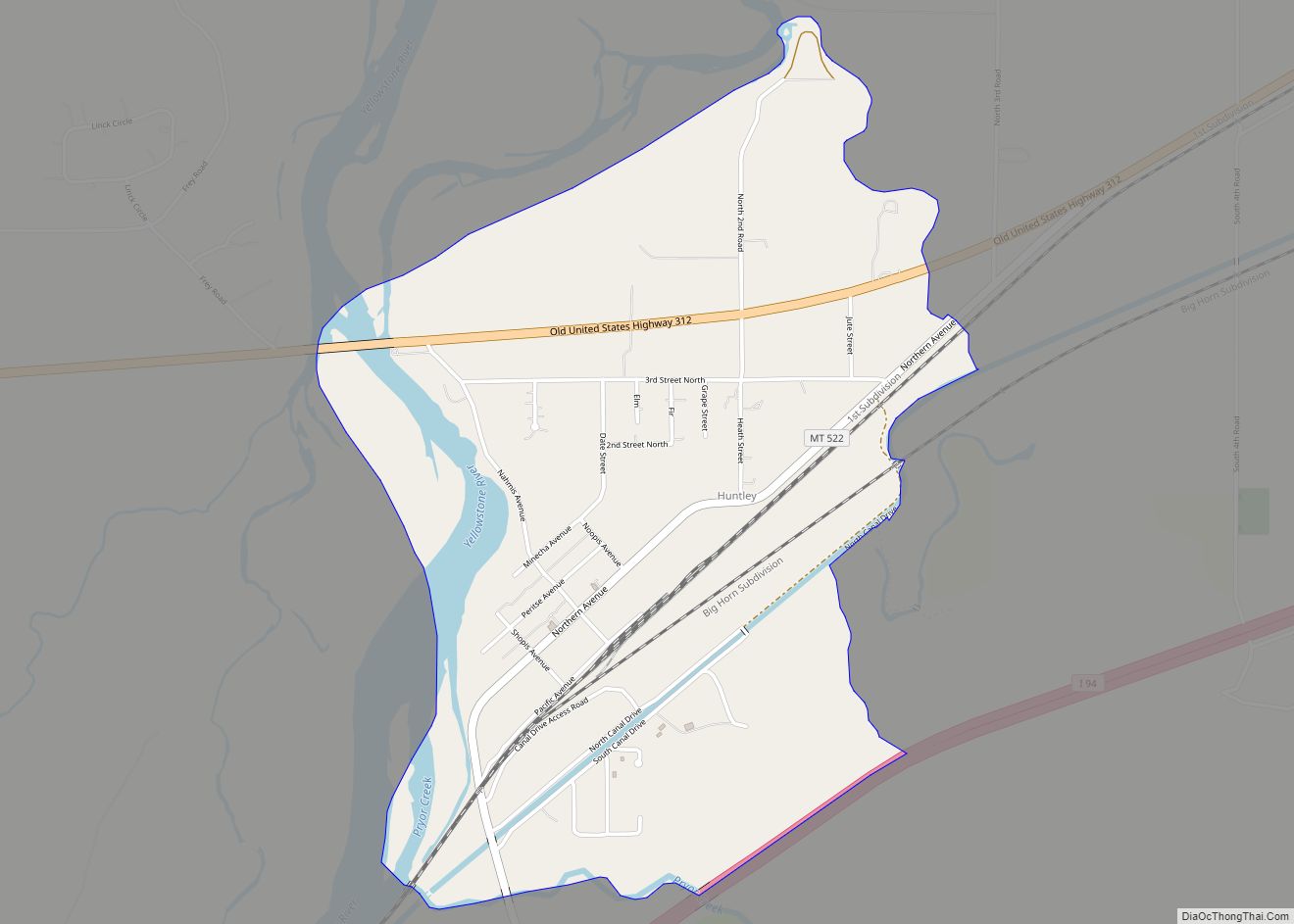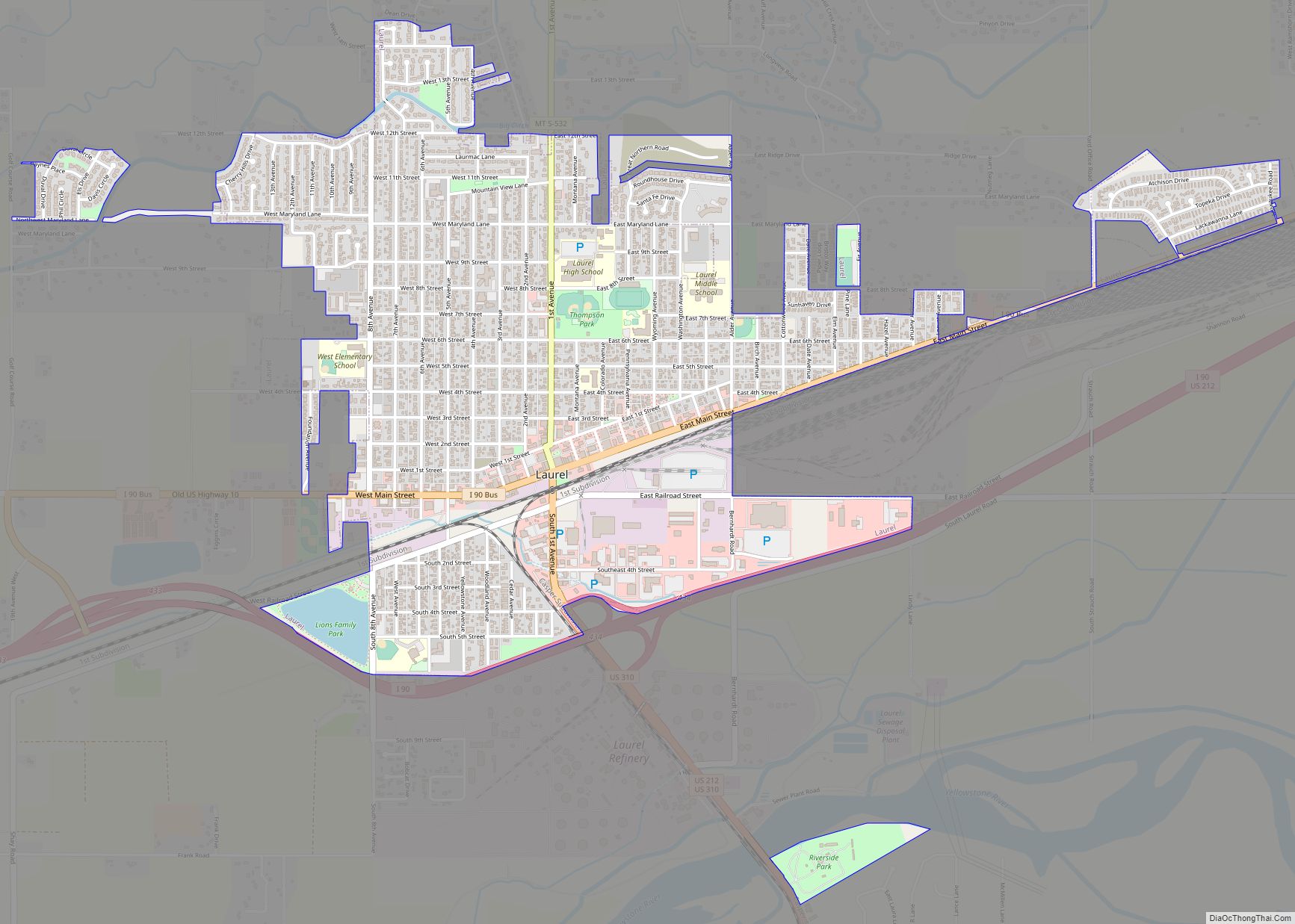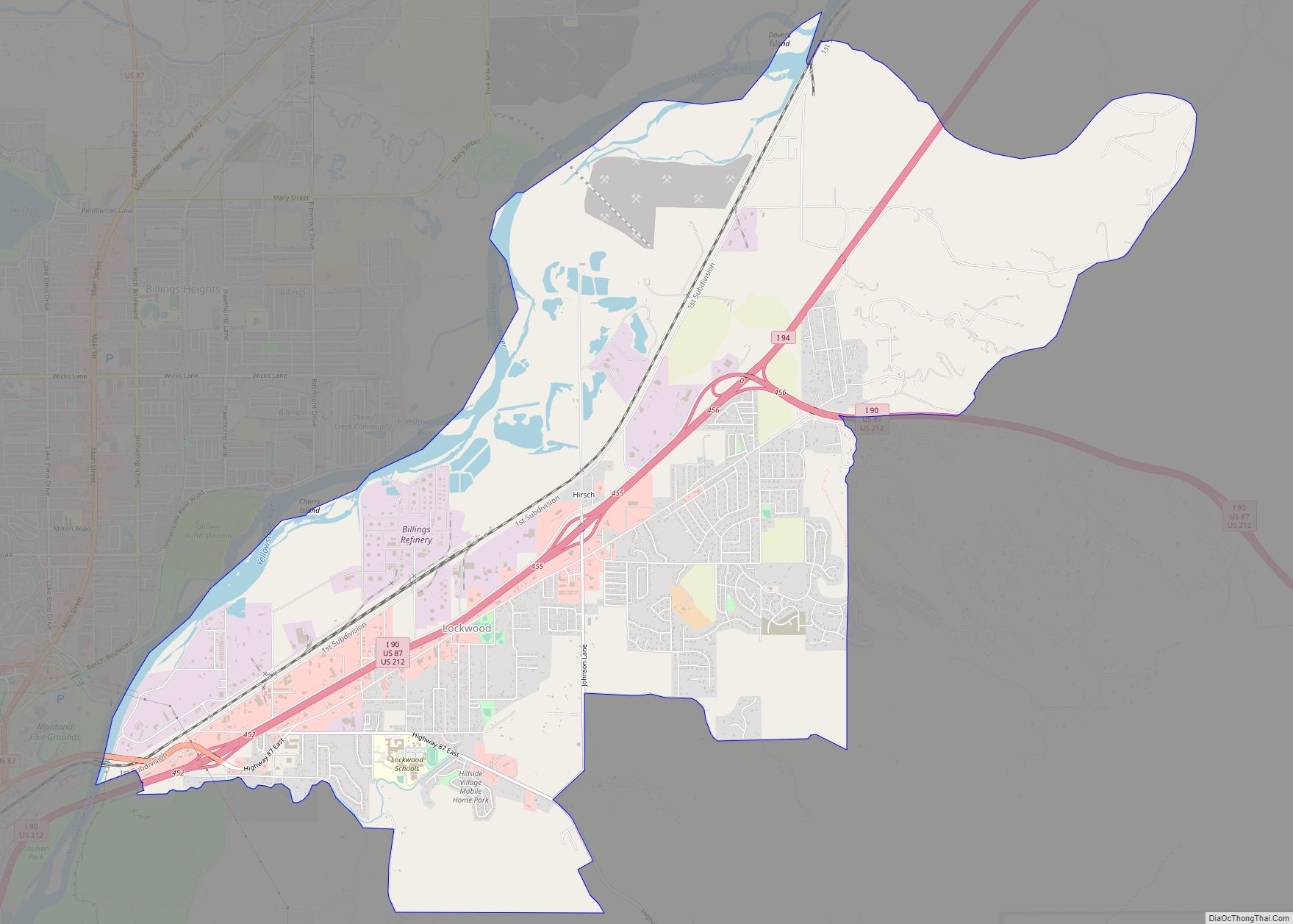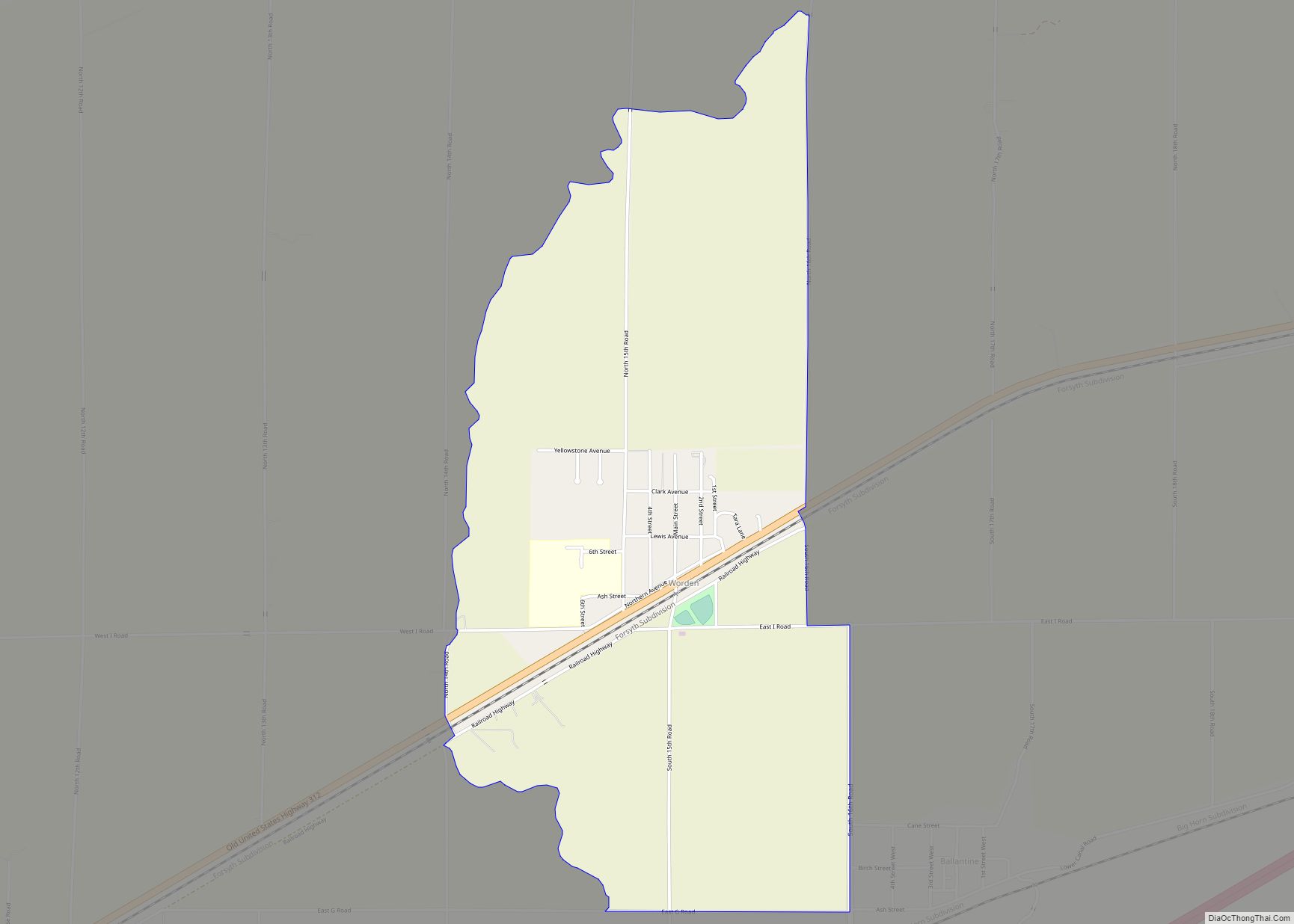Billings is the largest city in the U.S. state of Montana, with a population of 117,116 as of the 2020 census. Located in the south-central portion of the state, it is the seat of Yellowstone County and the principal city of the Billings Metropolitan Area, which had a population of 184,167 in the 2020 census.
Billings was nicknamed the “Magic City” because of its rapid growth from its founding as a railroad town in March 1882. The nearby Crow and Cheyenne peoples called the city Ammalapáshkuua and É’êxováhtóva respectively.
With one of the largest trade areas in the United States, Billings is the trade and distribution center for much of Montana east of the Continental Divide. Billings is also the largest retail destination for much of the same area. The Billings Chamber of Commerce claims the area of commerce covers more than 125,000 square miles. In 2009, it was estimated to serve over 500,000 people.
The city has experienced rapid growth and maintains a strong economy. From 1969 to 2021, the Billings area population growth was 89%, compared to Montana’s overall increase of 59%. Parts of the metro area are seeing hyper growth. From 2000 to 2010 Lockwood, an eastern suburb, saw growth of 57.8%, the largest growth rate of any community in Montana. In 2020, the area experienced its highest growth rate in a decade with a 2.3% increase.
Billings avoided the economic downturn that affected most of the nation from 2008 to 2012 as well as the housing bust. With more hotel accommodations than any area within a five-state region, the city hosts a variety of conventions, concerts, sporting events, and other rallies. With the nearby Bakken oil development, the largest oil discovery in U.S. history, as well as the Heath Shale oil discovery north of Billings, the city’s growth rate stayed high during the shale oil boom.
Attractions in and around Billings include ZooMontana, the Yellowstone Art Museum, Pompey’s Pillar, Pictograph Cave, Chief Plenty Coups State Park. Little Bighorn Battlefield, Bighorn Canyon, Red Lodge Mountain, and the Beartooth Highway. The northeast entrance to Yellowstone National Park is a little over 100 miles (160 km) from Billings.
| Name: | Billings city |
|---|---|
| LSAD Code: | 25 |
| LSAD Description: | city (suffix) |
| State: | Montana |
| County: | Yellowstone County |
| Founded: | 1877 |
| Incorporated: | March 24, 1882 |
| Elevation: | 3,124 ft (952 m) |
| Land Area: | 45.29 sq mi (117.29 km²) |
| Water Area: | 0.11 sq mi (0.28 km²) |
| Population Density: | 2,586.08/sq mi (998.50/km²) |
| ZIP code: | 59101-59117 |
| Area code: | 406 |
| FIPS code: | 3006550 |
| GNISfeature ID: | 802034 |
| Website: | www.billingsmt.gov |
Online Interactive Map
Click on ![]() to view map in "full screen" mode.
to view map in "full screen" mode.
Billings location map. Where is Billings city?
History
Name
The city is named for Frederick H. Billings, a former president of the Northern Pacific Railroad from Woodstock, Vermont. An earlier name for the area was Clark’s Fork Bottom.
The Crow people from the nearby Crow Indian Reservation call the city Ammalapáshkuua. It means ‘where they cut wood’, and is named as such because of a sawmill built in the area by early white settlers. The Cheyenne from the nearby Northern Cheyenne Indian Reservation referred to the city as É’êxováhtóva, ‘sawing place’ and the Gros Ventre from the nearby Fort Belknap Indian Reservation referred to it as ʔóhuutébiθɔnɔ́ɔ́nh, ‘where they saw lumber’, both also named for the sawmill, or translations of the Crow name.
Prehistory
The downtown core and much of the rest of Billings is in the Yellowstone Valley, a canyon carved out by the Yellowstone River. Around 80 million years ago, the Billings area was on the shore of the Western Interior Seaway. The sea deposited sediment and sand around the shoreline. As the sea retreated, it left a deep layer of sand. Over millions of years, this sand was compressed into stone known as Eagle Sandstone. Over the last million years the river has carved its way down through this stone to form the canyon walls known as the Billings Rimrocks or the Rims.
The Pictograph Caves are about five miles south of downtown. These caves contain over 100 pictographs (rock paintings), the oldest of which is over 2,000 years old. Approximately 30,000 artifacts (including stone tools and weapons) have been excavated from the site. These excavations have proved the area has been occupied since at least 2600 BC until after 1800 AD.
The Crow Indians have called the Billings area home since about 1700. The present-day Crow Nation is just south of Billings.
Lewis and Clark Expedition
In July 1806, William Clark (of the Lewis and Clark Expedition) passed through the Billings area. On July 25 he arrived at what is now known as Pompey’s Pillar and wrote in his journal “… at 4 P M arrived at a remarkable rock, i ascended this rock and from its top had a most extensive view in every direction.” Clark carved his name and the date into the rock, leaving the only remaining physical evidence of their expedition. He named the place Pompey’s Tower, naming it after the son of his Shoshone interpreter and guide Sacajawea. In 1965, Pompey’s Pillar was designated as a national historic landmark, and was proclaimed a national monument in January 2001. An interpretive center has been built next to the monument.
Coulson/Billings
The area where Billings is today was known as Clark’s Fork Bottom. Clark’s Fork Bottom was to be the hub for hauling freight to Judith and Musselshell Basins. At the time these were some of the most productive areas of the Montana Territory. The plan was to run freight up Alkali Creek, now part of Billings Heights, to the basins and Fort Benton on the Hi-Line.
In 1877 settlers from the Gallatin Valley area of the Montana Territory formed Coulson the first town of the Yellowstone Valley. The town was started when John Alderson built a sawmill and convinced PW McAdow to open a general store and trading post on land Alderson owned on the bank of the Yellowstone River. The store went by the name of Headquarters, and soon other buildings and tents were being built as the town began to grow. At this time before the coming of the railroad, most goods coming to and going from the Montana Territory were carried on paddle riverboats. It is believed it was decided to name the new town Coulson in an attempt to attract the Coulson Packet Company that ran riverboats between St Louis and many points in the Montana Territory. In spite of their efforts the river was traversed only once by paddle riverboat to the point of the new town.
Coulson was a rough town of dance halls and saloons and not a single church. The town needed a sheriff and the famous mountain man John “Liver-Eating” Johnson took the job. Many disagreements were settled with a gun in the coarse Wild West town. Soon a graveyard was needed and Boothill Cemetery was created. It was called Boothill because most of the people in it were said to have died with their boots on. Today, Boothill Cemetery sits within Billings’ city limits and is the only remaining physical evidence of Coulson’s existence.
When the railroad came to the area, Coulson residents were sure the town would become the railroads hub and Coulson would soon be the Territories largest city. The railroad only had claim to odd sections and it had two sections side-by-side about two miles west of Coulson. Being able to make far more money by creating a new town on these two sections the railroad decided to create the new town of Billings, the two towns existed side by side for a short time with a trolley even running between them. However, most of Coulson’s residents moved to the new booming town of Billings. In the end Coulson faded away with the last remains of the town disappearing in the 1930s. Today Coulson Park, a Billings city park, sits on the river bank where Coulson once was.
Early railroad town
Named after the Northern Pacific Railway president Frederick H. Billings, the city was founded in 1882. The Railroad formed the city as a western railhead for its further westward expansion. At first the new town had only three buildings but within just a few months it had grown to over 2,000. This spurred Billings’ nickname of the Magic City because, like magic, it seemed to appear overnight.
The nearby town of Coulson appeared a far more likely site. Coulson was a rough-and-tumble town where arguments were often followed by gunplay. Liver-Eating Johnson was a lawman in Coulson. Perhaps the most famous person to be buried in Coulson’s Boothill cemetery is H.M. “Muggins” Taylor, the scout who carried the news of Custer’s Last Stand at the Battle of Little Bighorn to the world. Most buried here were said to have died with their boots on. The town of Coulson had been on the Yellowstone River, which made it ideal for the commerce steamboats brought up the river. However, when the Montana & Minnesota Land Company oversaw the development of potential railroad land, they ignored Coulson, and platted the new town of Billings just a couple of miles to the northwest. Coulson quickly faded away; most of her residents were absorbed into Billings. Yet, for a short time, the two towns coexisted; a trolley even ran between them. But ultimately there was no future for Coulson as Billings grew. Though it stood on the banks of the Yellowstone River only a couple of miles from the heart of present-day downtown Billings, the city of Billings never built on the land where Coulson once stood. Today Coulson Park sits along the banks of the Yellowstone where the valley’s first town once stood.
20th century
By the 1910 census, Billings’ population had risen to 10,031 ranking it the sixth fastest-growing community in the nation. Billings became an energy center in the early years of the twentieth century with the discovery of oil fields in Montana and Wyoming. Then the discovery of large natural gas and coal reserves secured the city’s rank as first in energy. In the early 20th century, its served as regional trading center and energy hub for eastern Montana and northern Wyoming, an area then known as the Midland Empire.
After World War II, Billings became the region’s major financial, medical and cultural center. Billings has had rapid growth from its founding; in its first 50 years growth was, at times, as high as 200 to 300 percent per decade.
Billings growth has remained robust throughout the years, and in the 1950s, it had a growth rate of 66 percent. The 1973 oil embargo by OPEC spurred an oil boom in eastern Montana, northern Wyoming and western North Dakota. With this increase in oil production, Billings became the headquarters for energy sector companies. In 1975 and 1976, the Colstrip coal-fire generation plants 1 and 2 were completed; plants 3 and 4 started operating in 1984 and 1986.
In the 1970s and 1980s, Billings saw major growth in its downtown core; the first high-rise buildings to be built in Montana were erected. In 1980, the 22-floor Sheraton Hotel was completed. Upon its completion, it was declared “the tallest load-bearing brick masonry building in the world” by the Brick Institute of America. During the 1970s and 1980s, other major buildings were constructed in the downtown core; the Norwest Building (now Wells Fargo), Granite Tower, Sage Tower, the MetraPark arena, the TransWestern Center, many new city-owned parking garages, and the First Interstate Center, the tallest building in a five-state area.
With the completion of large sections of the interstate system in Montana in the 1970s, Billings became a shopping destination for an ever-larger area. The 1970s and 1980s saw new shopping districts and shopping centers developed in the Billings area. In addition to the other shopping centers, two new malls were developed, and Rimrock Mall was redeveloped and enlarged, on what was then the city’s west end. Cross Roads Mall was built in Billings Heights, and West Park Plaza mall in midtown. Several new business parks were also developed on the city’s west end during this period.
Billings was affected by the 1980 eruption of Mount St. Helens in May; the city received about an inch of ash on the ground. The Yellowstone fires of 1988 blanketed Billings in smoke for weeks.
In the 1990s, the service sector in the city increased with the development of new shopping centers built around big box stores such as Target, Walmart and Office Depot, all of which built multiple outlets in the Billings area. With the addition of more interchange exits along I-90, additional hotel chains and service industry outlets are being built in Billings. Development of business parks and large residential developments on the city’s west end, South Hills area, Lockwood, and the Billings Heights were all part of the 1990s. Billings received the All-America City Award in 1992.
21st century
In the 21st century, Billings saw the development of operations centers in the city’s business parks and downtown core by such national companies as GE, Wells Fargo and First Interstate Bank. The Downtown Billings Alliance led efforts to transform downtown in order to increase economic and civic opportunities. In 2002, Skypoint was completed. This artistic structure provides a defining area to host events. Downtown saw a renaissance of the historic area as building after building was restored. In 2007, Billings was designated a Preserve America Community.
Various changes were made to make the city more environmentally friendly. The MET Transit Center for city buses received LEED Platinum status in 2010. This was the first transportation facility in the US to do so. In 2022, Billings received LEED Gold certification, the first city to do so in Montana and the 21st globally. Projects to achieve this status included increased efficiency at the water and waste water treatment plant, adding electric city buses and EV charging stations, and adding a conservation area to the west-end.
Significant road developments began, providing infrastructure for city growth. In 2000, a new exit on Interstate 90 was completed. Zoo Drive exit provides ease of access to the quickly growing west-end area. The Yellowstone River bridge is being rebuilt. The Billings Bypass project will create a new arterial roadway from Lockwood to the Heights.
The city saw a serious growth in businesses. With the completion of the Shiloh interchange exit, the TransTech Center was developed and more hotels were built. In 2010 the Shiloh corridor was open for business with the completion of the Shiloh parkway, a 4.8-mile (7.7 km) multi-lane street with eight roundabouts. This brought the first Kohl’s department store to Montana. Other new centers include Billings Town Square with Montana’s first Cabela’s, and West Park Promenade, Montana’s first open-air shopping mall. In 2009, Fortune Small Business magazine named Billings the best small city in which to start a business.
On June 20, 2010 (Father’s Day), a tornado touched down in the downtown core and Heights sections of Billings. The MetraPark Arena and area businesses suffered major damage.
In the 2010s, Eastern Montana and North Dakota experienced an energy boom due to the Bakken formation, the largest oil discovery in U.S. history.
Billings Road Map
Billings city Satellite Map
Geography
Two-thirds of the city is in the Yellowstone Valley and the South Hills area and one-third in the Heights-Lockwood area. The city is divided by the Rims, long cliffs, also called the Rimrocks. The Rims run to the north and east of the downtown core, separating it from the Heights to the north and Lockwood to the east, with the cliffs to the north being 500 feet (150 m) tall and to the east of downtown, the face rises 800 feet (240 m). The elevation of Billings is 3,126 feet (953 m) above sea level. The Yellowstone River runs through the southeast portion of the city. According to the United States Census Bureau, the city has an area of 43.52 square miles (112.72 km), of which 43.41 square miles (112.43 km) is land and 0.11 square miles (0.28 km) is water.
Around Billings, seven mountain ranges can be viewed. The Bighorn Mountains have over 200 lakes and two peaks that rise to over 13,000 feet (4,000 m): Cloud Peak, at 13,167 ft (4,013 m) and Black Tooth Mountain, at 13,005 ft (3,964 m). The Pryor Mountains directly south of Billings rise to a height of 8,822 feet (2,689 m) and are unlike any other landscape in Montana. They are also home the Pryor Mountain Wild Horse Range. The Beartooth Mountains are the location of Granite Peak, which at 12,807 feet (3,904 m) is the highest point in the state of Montana. The Beartooth Highway, a series of steep zigzags and switchbacks along the Montana–Wyoming border, rises to 10,947 feet (3,337 m). It was called “the most beautiful drive in America” by Charles Kuralt. The Beartooth Mountains are just northeast of Yellowstone National Park. The Crazy Mountains to the west rise to a height of 11,209 feet (3,417 m) at Crazy Peak, the tallest peak in the range. Big Snowy Mountains, with peaks of 8,600 feet (2,600 m), are home to Crystal Lake. The Bull Mountains are a low-lying heavily forested range north of Billings Heights. The Absaroka Range stretches about 150 mi (240 km) across the Montana–Wyoming border, and 75 miles (121 km) at its widest, forming the eastern boundary of Yellowstone National Park.
Climate
Downtown Billings has a hot-summer humid continental climate (Köppen: Dfa) depending on the isotherm used, closely bordering on semi-arid (Köppen: BSk), with dry, hot summers, and cold, dry winters. However, areas outside of downtown can have a hot-summer continental climate, even with the −3 °C (27 °F) isotherm, due to the urban heat island effect, as exemplified by the Billings Logan International Airport. In the summer, the temperature can rise to over 100 °F (37.8 °C) on an average of 1 to 3 days per year, while the winter will bring temperatures below 0 °F or −17.8 °C on an average of 12.9 days per year. The snowfall averages 57.4 inches (146 cm) a year, but because of warm chinook winds that pass through the region during the winter, snow does not usually accumulate heavily or remain on the ground for long: the greatest depth has been 33 inches (84 cm) on April 5, 1955, after a huge storm which dumped 4.22 inches (107 mm) of water equivalent precipitation as snow in the previous three days under temperatures averaging 26.7 °F (−2.9 °C).
The snowiest year on record was 2017–18, with 106.1 inches (269 cm), topping the 2013–14 previous record of 103.5 inches (263 cm). The first freeze of the season on average arrives by October 6 and the last is May 5. Spring and autumn in Billings are usually mild, but brief. Winds, while strong at times, are considered light compared with the rest of Montana and the Rocky Mountain Front.
Due to its location, Billings is susceptible to severe summer weather as well. On June 20, 2010, a tornado touched down in the Billings Heights and Downtown sections of the city. The tornado was accompanied by hail up to golf ball size, dangerous cloud-to-ground lightning, and heavy winds. The tornado destroyed a number of businesses and severely damaged the 12,000-seat MetraPark Arena.
Sections
Billings has many sections that comprise the whole of the city. The sections are often defined by Billings unique physical characteristics. For example, a 500-foot (150 m) cliff known as the “Rims” separates the Heights from downtown Billings.
There are 11 boroughs called “sections” within Billings’ city limits.
Neighborhoods and zones
The south side of Billings is probably the oldest residential area in the city, and it is the city’s most culturally diverse neighborhood. South Park is an old growth City park, host to several food fairs and festivals in the summer months. The Bottom Westend Historic District is home to many of Billings’ first mansions. Midtown, the most densely populated portion of the city is in the midst of gentrification on a level few, if any, areas in Montana have ever seen. New growth is mainly concentrated on Billings West End, where Shiloh Crossing is a new commercial development, anchored by Scheels, Montana’s largest retail store. Residentially, the West End is characterized by upper income households. Denser, more urban growth is occurring in Josephine Crossing, one of Billings’ many new contemporary neighborhoods. Downtown is a blend of small businesses and office space, together with restaurants and a walkable brewery district. The Heights, defined as the area of the city northeast of the Metra, is predominantly residential, and a new school was recently constructed to accommodate growth in the neighborhood.
Surrounding areas
Billings is the principal city of the Billings Metropolitan Statistical Area. The metropolitan area consists of three counties: Yellowstone, Stillwater, and Carbon. The population of the entire metropolitan area was at 184,167 in the 2020 Census.
See also
Map of Montana State and its subdivision:- Beaverhead
- Big Horn
- Blaine
- Broadwater
- Carbon
- Carter
- Cascade
- Chouteau
- Custer
- Daniels
- Dawson
- Deer Lodge
- Fallon
- Fergus
- Flathead
- Gallatin
- Garfield
- Glacier
- Golden Valley
- Granite
- Hill
- Jefferson
- Judith Basin
- Lake
- Lewis and Clark
- Liberty
- Lincoln
- Madison
- McCone
- Meagher
- Mineral
- Missoula
- Musselshell
- Park
- Petroleum
- Phillips
- Pondera
- Powder River
- Powell
- Prairie
- Ravalli
- Richland
- Roosevelt
- Rosebud
- Sanders
- Sheridan
- Silver Bow
- Stillwater
- Sweet Grass
- Teton
- Toole
- Treasure
- Valley
- Wheatland
- Wibaux
- Yellowstone
- Alabama
- Alaska
- Arizona
- Arkansas
- California
- Colorado
- Connecticut
- Delaware
- District of Columbia
- Florida
- Georgia
- Hawaii
- Idaho
- Illinois
- Indiana
- Iowa
- Kansas
- Kentucky
- Louisiana
- Maine
- Maryland
- Massachusetts
- Michigan
- Minnesota
- Mississippi
- Missouri
- Montana
- Nebraska
- Nevada
- New Hampshire
- New Jersey
- New Mexico
- New York
- North Carolina
- North Dakota
- Ohio
- Oklahoma
- Oregon
- Pennsylvania
- Rhode Island
- South Carolina
- South Dakota
- Tennessee
- Texas
- Utah
- Vermont
- Virginia
- Washington
- West Virginia
- Wisconsin
- Wyoming
